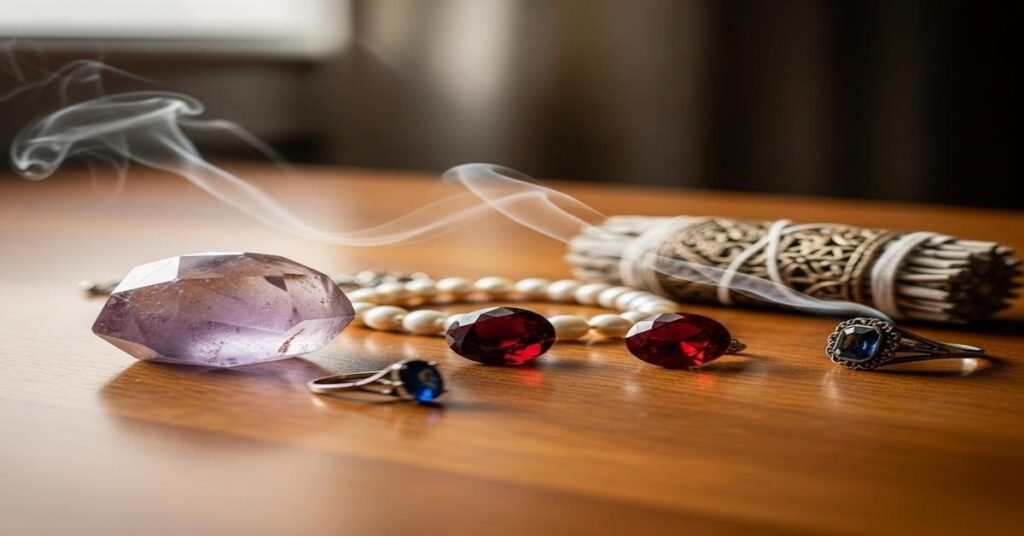Heirloom gems often carry stories. People ask whether they can also carry the “energy” of a previous owner. The short answer is: there is no scientific proof that stones hold personality or memories. But heirlooms do carry real, measurable traces of their past: wear, repairs, treatments, and the emotional weight of history. Understanding those traces helps you decide how to care for the piece and how to “reset” it for a new wearer.
What stones can and cannot “hold” from the past
Physically, a gem preserves evidence of its history. Look for chips, nicks, repolishing, worn facets, or old solder marks on the mounting. These are objective signs of use. For example, a 1 ct round brilliant diamond (about 6.5 mm) might show a culet chip. An emerald—often filled with oil or resin—may show cloudy filled fractures that indicate past restoration. Metals also tell a story: 14k gold (58.3% gold) will patina and may have thinning on prongs; sterling silver (92.5% Ag) tarnishes. These physical signs are why jewelers insist on inspection before any service.
Subjectively, people project meanings onto objects. Memory, grief, and expectation shape how we feel when we wear something. If you expect an antique ring to feel “haunted,” small coincidences will reinforce that belief. That’s how psychological attachment works, not a measurable property of the gemstone.
Scientific limits
Gems are minerals. They do not store emotions in any way that can be measured. What they do store are chemical and physical changes. Heat treatments, fracture filling, or re-cutting alter a gem’s structure. For example, heat-treated sapphire remains chemically the same but its color and internal inclusions change. An emerald treated with cedar oil or resin will respond differently to solvents and heat. Those treatments are why you should get a gem identified by a lab or experienced gemologist before attempting any deep cleaning or repairs.
Why a reset ritual can help
Reset rituals work for two reasons. First, practical restoration removes physical reminders of the past. Cleaning, prong repair, and re-setting change the object in measurable ways. A prong rebuild on a 0.75 ct center stone improves safety. Re-rhodiuming a white gold setting restores color because rhodium is a reflective plating. Second, ritual creates psychological closure. A deliberate act—cleaning, photographing, and setting an intention—gives the new owner control. That changes how the piece is experienced.
Safe practical steps to “reset” an heirloom
- Document first. Photograph the piece from multiple angles. Note hallmarks, inscriptions, and any damage. This preserves provenance and helps appraisers.
- Get a professional appraisal and ID. A lab report tells you if a diamond is natural, or if a sapphire is heat-treated. This affects cleaning and value.
- Inspect the setting. Check prongs, bezels, and solder joints. Weak prongs on a 2.0 mm diamond accent stone risk loss. Repair before regular wear.
- Clean properly. For hard stones (diamond, ruby, sapphire) and solid gold settings, warm water, mild dish soap, and a soft brush are safe. For fragile or treated stones (emeralds, opals, pearls, turquoise, amber, coral), avoid ultrasonic or steam cleaning. Pearls should be wiped with a damp soft cloth.
- Avoid home ultrasonic or steam use on certain gems. Emeralds with oil/resin fillings will be damaged by steam and some ultrasonics. Opal doublets and triplets can delaminate in water. If you’re not sure, hand-clean or consult a jeweler.
- Consider conservation over restoration. If the item is antique and has collector value, minimal intervention may be best. Removing original patina or replacing original settings can reduce historical value.
- Rhodium and re-plating. White gold often has a thin rhodium layer. Re-plating restores color and reduces skin reactions. Expect 0.5–1.0 microns of rhodium; it will wear again over time.
- Re-cutting or repolishing. Re-cutting a worn antique diamond can increase brilliance but reduces carat weight. For example, recutting an old European-cut 1.2 ct stone might drop it by 0.1–0.3 ct. Balance aesthetic gain against value loss.
Energetic or ceremonial reset rituals
These practices don’t change the gem physically, but they change how you relate to it. If you prefer a ceremony, combine it with practical care.
- Clean first. Physically washing or having a jeweler service the piece grounds the ritual in action.
- Set intention. Hold the item and state what you want it to represent. Say it aloud or write it down. This provides psychological clarity and changes meaning.
- Smudging or smoke cleanse. Passing the piece through sage or palo santo smoke is low risk to hard gems. Keep it short to avoid soot buildup.
- Sun or moon light. A few hours in indirect sunlight or overnight moonlight is safe for many stones. Avoid bright sun for more than a few hours on amethyst, kunzite, or tanzanite; they can fade.
- Secure keepsake. Keep a small note or photo inside a jewelry box to mark the transition.
Warnings and trade-offs
If the heirloom is valuable, treat changes carefully. Replacing an original setting or altering an inscription can reduce market and historical value. Extremely old metals or soldered repairs sometimes should be left as-is for conservation reasons. If the stone was treated (fracture-filled emerald or composite opal), some reset rituals can damage it. Always ask a qualified jeweler or conservator when in doubt.
Bottom line
Gems don’t store emotions in a physical sense. They do keep physical records: wear, treatments, and repairs. A combined approach works best. Start with documentation and professional inspection. Do necessary repairs and safe cleaning. Then use a short, intentional ritual to claim the piece emotionally. That practical-and-ceremonial approach removes real risks and helps you make the heirloom feel like yours.
I am G S Sachin, a gemologist with a Diploma in Polished Diamond Grading from KGK Academy, Jaipur. I love writing about jewelry, gems, and diamonds, and I share simple, honest reviews and easy buying tips on JewellersReviews.com to help you choose pieces you’ll love with confidence.

